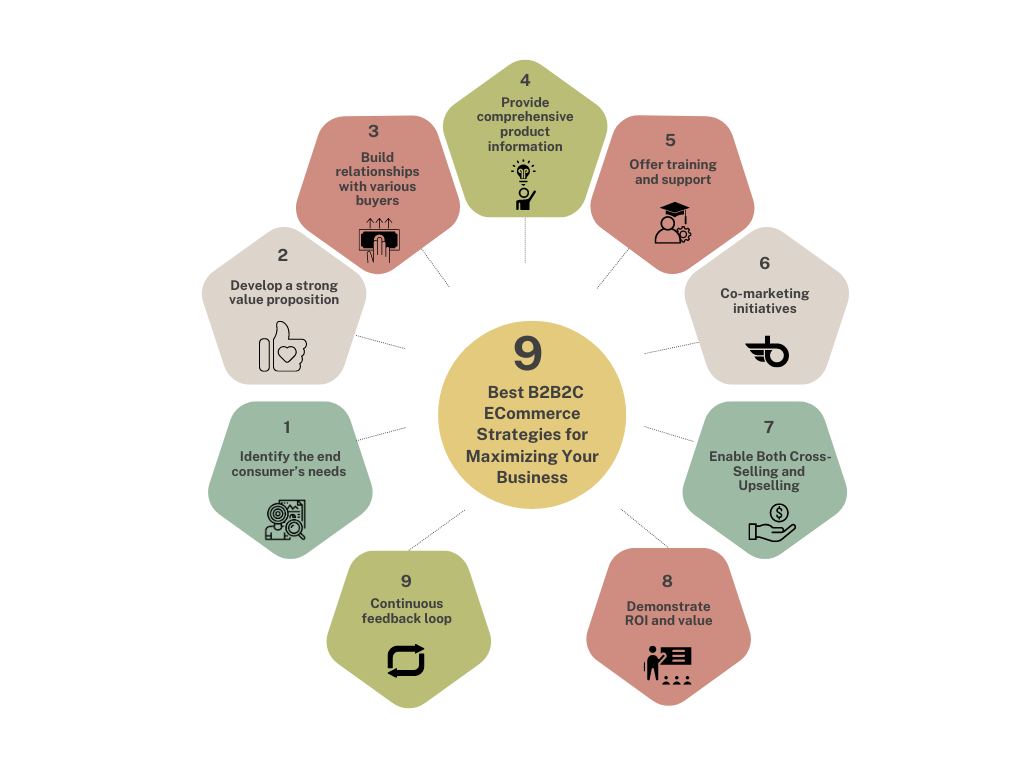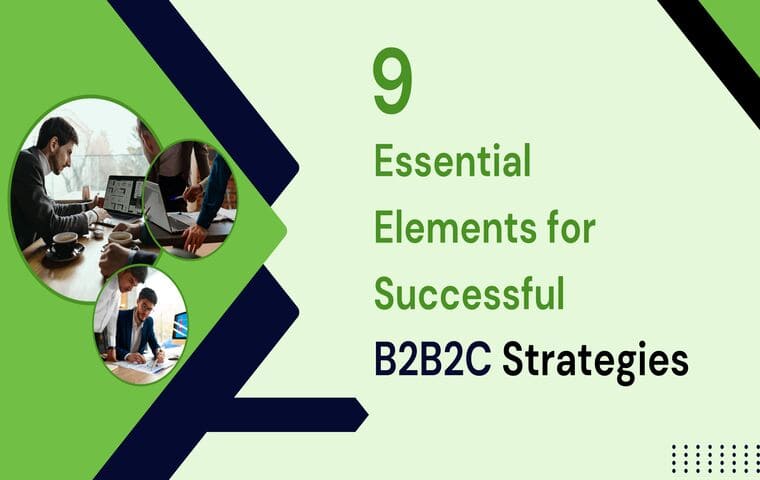Reading time 8 minutes
B2B2C, or business-to-business-to-consumer, is a collaborative business model where a company sells its products or services to another business. which then sells those products or services to individual consumers. It functions similarly to collaborating between two companies to reach final consumers.
In a B2B2C model, the first business (B2B) acts as an intermediary or middleman between the original company (the product or service provider) and the end consumers (B2C). The B2B company typically adds value to the product or service in some way before selling it to the end consumers.
Nearly 40% of manufacturers are actively pursuing the adoption of the B2B2C model. This trend signals a growing acceptance and evolution of this approach. It’s imperative for forward-looking brands to swiftly optimize their B2B2C strategies to stay competitive in this shifting landscape.
Exploring B2B2C Dynamics with some examples
This business model is often seen in industries such as technology, e-commerce, and retail. Let us get an insight into the B2B2C business process through several examples.
Amazon Business
Amazon Business is like a middleman between companies and customers, which is a good example of B2B2C. It makes buying easier for big buyers by letting multiple people use one account and customizing how orders are approved. Plus, it helps brands sell their stuff by offering a wide range of products and good shipping.
eBay
eBay, the famous online store, works as a bridge between businesses and shoppers, showing how B2B2C works. Sellers can reach lots of individual buyers through eBay’s easy-to-use website. With tools for sellers and options like bidding or buying right away, eBay makes it simple for businesses to sell to customers directly.
Alibaba
Alibaba, a huge online market, links companies that make products with people who want to buy them. Businesses can sell their stuff to lots of customers worldwide, and buyers can find all sorts of things to buy. Alibaba’s website is easy to use, and it has safe ways to pay, so companies can sell directly to customers without any hassle.
Here’s how the B2B2C model works:
Tesla and Home Depot established a partnership where Tesla supplies its electric vehicle charging stations, Powerwalls (home energy storage systems), and other related products to Home Depot. Tesla becomes a supplier/vendor for Home Depot, selling its products to them at wholesale prices.
Home Depot integrates Tesla’s products into its retail stores and online platforms, making them available for purchase by Home Depot’s customers. Home Depot markets and promotes these Tesla products to its customer base, which consists of homeowners and contractors.
The end customers, who are homeowners or contractors, visit Home Depot either in-store or online to purchase Tesla’s products. They can choose from a range of Tesla’s electric vehicle charging solutions and other sustainable energy products offered through the Home Depot platform.
Through this B2B2C model, Tesla benefits by reaching a wider customer base through Home Depot’s extensive retail network. Home Depot benefits by expanding its product offerings with innovative, eco–friendly solutions provided by Tesla. Lastly, customers benefit from having convenient access to Tesla’s products through a trusted retailer like Home Depot.
A Comparative Analysis of B2B, B2C, and B2B2C Enterprises
B2B, B2C, and B2B2C are abbreviations commonly used in the context of business models and marketing strategies. They represent different approaches to conducting business and interacting with customers. Here’s a breakdown of what each acronym stands for and the main differences between them:
1. B2B (Business-to-Business):
B2B refers to transactions and relationships that occur between two businesses. In B2B Marketing, companies sell their products or services directly to other businesses, rather than individual consumers. The target customers are typically other organizations, such as wholesalers, retailers, manufacturers, or service providers. B2B transactions often involve larger order volumes, longer sales cycles, and a focus on meeting the needs of the business as a whole rather than individual preferences.
Example: A company that produces computer components sells its products to a computer manufacturer.
3 Key Characteristics of B2B:
Business-focused: Sales and marketing efforts are directed toward meeting the needs of other businesses.
Relationship-driven: Building long-term relationships and fostering trust are crucial to secure and maintain B2B partnerships.
Complexity: B2B transactions tend to involve more complex pricing structures, negotiation processes, and decision-making units.
2. B2C (Business-to-Consumer):
B2C refers to transactions and interactions that occur between a business and individual consumers. In a B2C model, companies sell their products or services directly to end-users or individual customers. The target market consists of individual buyers who purchase goods or services for personal use or consumption. B2C transactions often involve smaller order sizes, shorter sales cycles, and a focus on individual preferences and convenience.
Example: An online retailer selling clothing directly to consumers through its website.
3 Key characteristics of B2C:
Consumer-focused: Sales and marketing efforts are geared toward appealing to individual consumers, their preferences, and needs.
Mass market: B2C marketing transactions often involve a broader customer base and aim to reach a large number of consumers.
Convenience and speed: B2C transactions prioritize ease of purchase, convenience, and efficient delivery processes to meet individual customer demands.
3. B2B2C (Business-to-Business-to-Consumer):
B2B2C is a hybrid model that combines elements of both B2B and B2C. In this model, a business sells its products or services to another Business (B2B), which, in turn, sells the products or services to end consumers (B2C). It involves a partnership or collaboration between two businesses, where one acts as the supplier or provider, and the other acts as a distributor or retailer.
3 Key characteristics of B2B2C:
Partnership-oriented: It relies on collaboration and coordination between two businesses to reach and serve end consumers effectively.
Value chain integration: The two businesses work together to create a seamless experience for the end consumers, where the B2B partner’s product or service becomes part of the B2C partner’s offerings.
Expanded reach and distribution: B2B2C allows the B2B company to tap into the B2C partner’s customer base and leverage its existing distribution channels.
9 Best B2B2C eCommerce Strategies for Maximizing Your Business

1. Identify the end consumer’s needs:
Understand the target consumer segment that your B2B2C customers serve. Do market research, create customer profiles, and find out their problems. Also, keep an eye on trends and ask for feedback. This helps offer the right products, making customers happy and boosting sales.
2. Develop a strong value proposition:
Clearly articulate the value your product or service brings to both the B2B2C business and the end consumer. Find what makes them unique and valuable to both the businesses you work with and the people who buy from them.
Make sure to talk about how you solve their problems or make their lives better. Use clear language that everyone can understand and keep your message consistent everywhere you talk about your business.
3. Build relationships with various buyers:
In B2B2C eCommerce, it’s important to build relationships with both the businesses you work with and the end consumers who buy your products or services. Listen to their needs, communicate well, and offer value-added services. Personalize your interactions and always seek feedback to improve.
strong>4. Provide comprehensive product information:
B2B2C businesses act as intermediaries, so they need to understand your product or service thoroughly to sell it to the end consumer effectively.
Provide comprehensive product information, specifications, user manuals, and any other relevant material that helps B2B2C companies understand and promote your offerings.
5. Offer training and support:
Conduct training sessions and provide support to the B2B2C businesses on how to effectively sell your product or service to the end consumer.
This could include sales training, product demonstrations, and marketing collateral. The better equipped the B2B2C businesses are, the more effectively they can promote your offerings.
6. Co-marketing initiatives:
Collaborate with your B2B2C customers on co-marketing initiatives to increase brand awareness and reach the end consumers.
This could include joint marketing campaigns, co-branded materials, or even shared social media promotions. By aligning your marketing efforts, you can leverage each other’s networks and enhance visibility.
7. Enable Both Cross-Selling and Upselling
Cross-selling and upselling are great strategies for B2B2C brands. They help you offer more products or services to customers. These techniques are useful when you have related items, as they let you sell more to your existing customers and boost sales. Make sure you offer both cross-selling and upselling options. This way, you can suggest complementary products and encourage customers to upgrade to better versions.
8. Demonstrate ROI and value:
Show the B2B2C businesses the return on investment (ROI) they can expect by partnering with you.
Provide case studies, testimonials, and data-driven evidence that highlights the value your product or service delivers to the end consumer. This will help build confidence in your offerings and increase sales.
9. Continuous feedback loop:
Establish a feedback loop with the B2B2C businesses to gather insights on the end consumers’ experiences, preferences, and feedback.
Use this information to refine your product or service offering and improve the customer experience. Actively listening and incorporating feedback can strengthen relationships and drive sales.
Conclusion
In summary, creating a powerful B2B2C advertising plan means using different smart strategies. These 9 B2B2C eCommerce strategies help businesses grow in collaborative selling. This includes using data, making partnerships, and personalizing marketing. As things change in B2B2C, it’s key to be flexible and keep trying new things.
Get in touch! with Fountmedia’s mailing database, which helps you reach buyers in any sector for your sales campaigns. It facilitates all the email lists required including business email lists, industry-specific mailing lists, or any data-appending services for your business. We follow all privacy rules like CAN-SPAM and GDPR to give you accurate leads and get our updated data.
Still, have any doubts? Look no further than FountMedia! Just contact our Customer support team at +1-732-703-9915.



